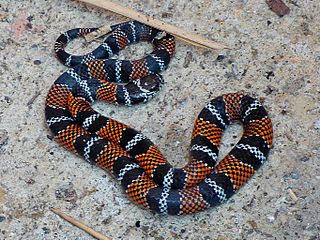
The royal ground snake is a species of snake in the family Colubridae. The species is endemic to northern South America.

Erythrolamprus cobella, commonly known as the mangrove snake, is a species of small semi-aquatic snake, which is endemic to South America.
Erythrolamprus ocellatus, commonly known as the Tobago false coral snake, red snake, or doctor snake is a species of colubrid snake, which is endemic to the island of Tobago.

Erythrolamprus bizona, commonly known as the double-banded false coral snake, is a species of colubrid snake, which is endemic to northern South America and Central America.

Erythrolamprus aesculapii, also known commonly as the Aesculapian false coral snake, the South American false coral snake, and in Portuguese as bacorá, or falsa-coral, is a species of mildly venomous snake in the family Colubridae. The species is endemic to South America.

James Ray Dixon was professor emeritus and curator emeritus of amphibians and reptiles at the Texas Cooperative Wildlife Collection at Texas A&M University. He lived in El Campo, Texas, throughout most of his childhood. He published prolifically on the subject of herpetology in his distinguished career, authoring and co-authoring several books, book chapters, and numerous peer reviewed notes and articles, describing two new genera, and many new species, earning him a reputation as one of the most prominent herpetologists of his generation. His main research focus was morphology based systematics of amphibians and reptiles worldwide with emphasis on Texas, US, Mexico, Central America, and South America, although bibliographies, conservation, ecology, life history and zoogeography have all been the subjects of his extensive publications.

Crotalus viridis is a venomous pit viper species native to the western United States, southwestern Canada, and northern Mexico. Currently, two subspecies are recognized, including the prairie rattlesnake, the nominate subspecies, and the Hopi rattlesnake.

Erythrolamprus is a genus of colubrid snakes, commonly known as false coral snakes, native to Central America, the Caribbean, and the northern part of South America. They appear to be coral snake mimics.
Dixon's ground snake is a species of snake in the family Colubridae. The species is endemic to Southeastern Brazil.

The military ground snake is a species of snake in the family Colubridae. The species is endemic to South America.

The Brazilian coral snake is a species of coral snake in the family Elapidae.

The Brazilian burrowing snake is a snake endemic to Brazil. It is monotypic in the genus Gomesophis.

Erythrolamprus almadensis, the Almaden ground snake, is a species of snake in the family Colubridae. The species is found in Brazil, Paraguay, Argentina, Uruguay, Bolivia, and Peru.
Erythrolamprus andinus is a species of snake in the family Colubridae. The species is found in Bolivia and Peru.
Erythrolamprus carajasensis is a species of snake in the family Colubridae. The species is found in Brazil.
Erythrolamprus frenatus, the swamp liophis, is a species of snake in the family Colubridae. The species is found in Brazil, Paraguay, and Argentina.
Erythrolamprus maryellenae, Maryellen's ground snake, is a species of snake in the family Colubridae. The species is found in Brazil.
Erythrolamprus mossoroensis is a species of snake in the family Colubridae. The species is found in Brazil.
Erythrolamprus oligolepis is a species of snake in the family Colubridae. The species is found in Brazil, Venezuela, and Peru.

Erythrolamprus taeniogaster is a species of snake in the family Colubridae. The species is found in Brazil, Colombia, Venezuela, Suriname, French Guiana, Peru, and Bolivia.











